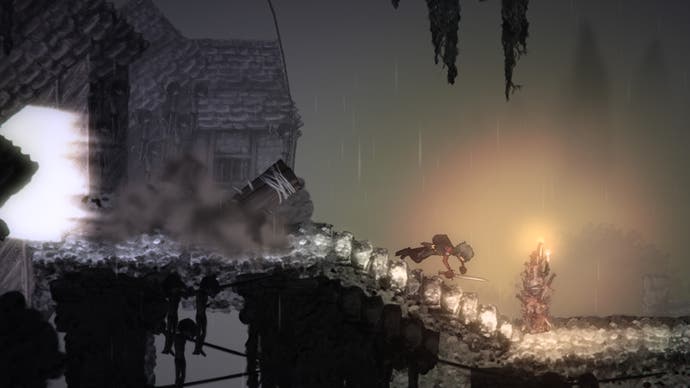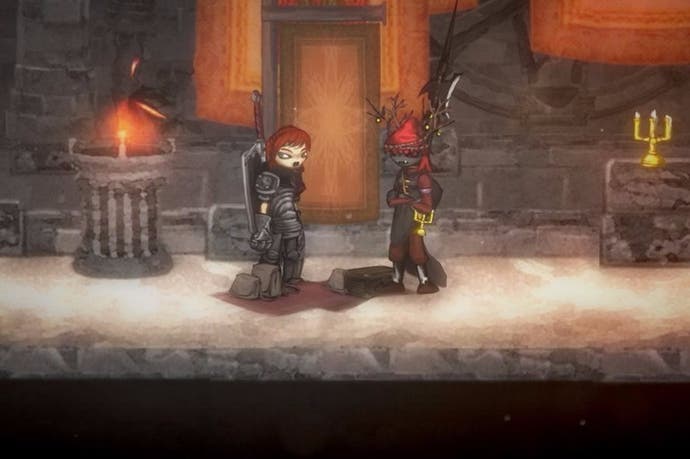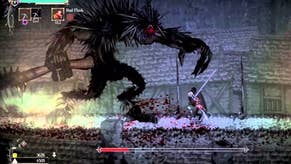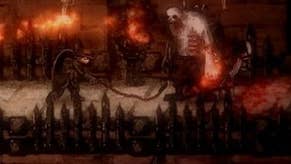Salt and Sanctuary review
Praise the salt!
Lots of games compare themselves to Dark Souls these days. Why wouldn't they? From Software's instant classic began as a niche import with Demon's Souls before taking the world by storm and spreading its influence everywhere. "It's like Dark Souls with zombies" Ubisoft would say about Zombi U. "It's like Dark Souls with cars" people have said of Dirt Rally. So when you hear that The Dishwasher: Vampire Smile developer Ska Studios' non-linear action platformer Salt and Sanctuary was going to be "like Dark Souls", it's easy to write it off as another buzzword attempted to raise interest in the umpteenth metroidvania on the digital market. But good lord, this is a lot like Dark Souls.
Ska Studios doesn't try to hide that fact. Salt and Sanctuary is so beholden to Dark Souls' template that it's a little shocking the two-person Seattle studio hasn't been sued. Not only does Salt and Sanctuary crib the Souls series' unique respawn mechanic - in which you need to reclaim your lost experience by retracing your steps - it copies Souls' entire combat system and RPG structure wholesale. You fight by managing your stamina meter that temporarily depletes with every strike, block, and roll. You equip various pieces of armour, weapons, and rings with a weight system that influences your mobility based on how much gear you're currently wearing. There's even stats for Strength and Dexterity that scale your weapons' damage output on an E through S ranking system. The list goes on and on.
This borderline plagiarism should be repulsive - and on some level it is - yet Salt and Sanctuary survives this obvious intellectual thievery based on two conditions: it creatively adapts From Software's template to a 2D plane, and it's a damn fine imitation.

Let's focus on that first point for a moment. This new perspective gives Salt and Sanctuary's exploration and combat a sense of deja vu with a different series: Castlevania. Koji Igarashi and co. were letting us explore a non-linear gothic landscape long before From Software entered the fray, though it's been several years since Konami issued a 2D outing in the famous franchise. Amusingly, these two series already seemed to be colliding with From Software's most recent outing Bloodborne feeling like Dark Souls in Castlevania's clothing. By the same token, Salt and Sanctuary feels like Castlevania donning Souls' whole wardrobe, and in a weird way Ska's obvious cribbing has resulted in a novel missing link between these two fabled franchises.
One interesting discovery upon merging these two inspirations is how different navigation feels in a 2D world without a map. While non-linear platforming adventures like Symphony of the Night and Metroid provided players with maps so that they wouldn't get lost, Dark Souls wanted players to feel lost and made memorising its labyrinthine layouts part of the puzzle. That sort of freeform navigation worked well in a 3D environment, when players had more peripheral vision and could see off into the distance. In 2D, however, it's a somewhat greater struggle to navigate. This isn't necessarily a bad thing, though, as it ends up giving Salt and Sanctuary a unique feel, even if it's seemingly assembled out of spare parts.
As to my other point: Ska Studios handles this unlicensed conversion remarkably well. Combat is thick and crunchy, with each boss and enemy type having its own strengths and weaknesses, making experimentation with different equipment layouts and strategies is important. As was the case in Dark Souls, figuring out when it's best to block, dodge, and whether to go in with heavy armour or light can tip the scales drastically in your favour. Sorting your own path to victory in Salt and Sanctuary's deep combat system is a pleasure. It may be built upon someone else's foundation, but it's been captured so authentically in a 2D side-scrolling perspective it feels like an incredible achievement.
It's not just the combat Ska gets right, as the level design cunningly apes Dark Souls as well. Looping corridors and surprising shortcuts are a mainstay in these sorts of games, but it's not until later on that you realise just how intricate the level design is. Each area of the map is littered with obscure secrets and hidden loot providing ample incentive to retrace your steps later with new gear. Towards the endgame you'll even come across whole areas and bosses that are entirely missable. The fact that these large pockets of content are shrouded off the beaten path only makes discovering them feel that much more like an actually discovery. It's a risky prospect for developers to spend that much time on optional, hidden features, but Ska understands just how rewarding unearthing this clandestine content can be.
There's even room for a few original ideas from Ska, even if they're relatively modest in practice. The way death works has been slightly tweaked from Dark Souls in that gold and experience points are different currencies and only one is recoverable upon death. Your gold - used to buy items - is gone for good, adding a more menacing edge to each game over. Enemies also liberally drop gold when slain, and constantly collecting shiny loot drops is one of those tiny platformer pleasures that's lost in the proper Souls series. There's also a neat system where you use limited items to summon shopkeepers and blacksmiths to your sanctuaries, adding a sense of anxiety about where to lay down roots in this ever-expanding adventure.

There are a few places where Ska's ambition exceeds its reach. The studio's cartoon goth visual sensibilities aren't the best fit here. The angsty-teenager-doodling-in-their-margin aesthetic worked well enough for Ska's modest-sized beat-'em-up The Dishwasher series, but in a game as sprawling as Salt and Sanctuary the art direction is neither as varied nor majestic as the game's obvious inspirations. The dialogue also captures some of From's penchant for elliptical prose, but none of its darkly romantic allure. Fourth wall-breaking referential gags, like a message riffing on Dark Souls' most familiar mantra ("Praise the salt!"), are similarly unwelcome. [Editor's note: The developer has informed us that this was a user-generated message. Apologies for the error.] These blemishes scream "low-budget fan tribute", coating Salt and Sanctuary with an icky envious amateur vibe that contrasts greatly with the Souls series' solemn gravitas.
Salt and Sanctuary feels like the work of a teenager who really wants to make a Dark Souls game - if that teenager was also really, really good at game design. It isn't quite as good as a proper Souls or Castlevania game, but that it gets as close as it does to capturing the thrill of such storied series is a remarkable achievement for such a tiny team. The most frustrating thing about Salt and Sanctuary is how very close it is to a masterpiece. What if Ska had joined forces with From Software to make a licensed 2D Souls game with the original developer's art department and writers? If only a larger team had worked on it to provide extra polish in the spots outside Ska's limitations. Imagine if it had the visual fidelity and creative spark of something like Ori and the Blind Forest or Cave Story.
With just a little more spit, polish and imagination, Salt and Sanctuary could have been a timeless classic. As is, it's very obviously a fan-made tribute act, but what a tribute act it is. Given that Dark Souls 3 may signal the end of that franchise and Koji Igarashi's Castlevania successor Bloodstained is still a long way off, Salt and Sanctuary provides a thoroughly enjoyable imitation in the interim. Worth one's salt, then.















